Study on the Spatial Layout and Influencing Factors of Campsites in the Yellow River Basin
Abstract
1. Introduction
1.1. Background
1.2. Literature Review
1.2.1. Campground Operation Management Research
1.2.2. Research on Sustainable Development of Campgrounds
1.2.3. Campsite Planning Study
2. Data Sources and Study Area
2.1. Data Sources
- (1)
- Map data, DEM elevation, and natural environment indicators were obtained from the Data Center for Resources and Environmental Sciences of the Chinese Academy of Sciences (https://www.resdc.cn/, accessed on 28 May 2024), websites of provincial water conservancy departments, and the 2023 Provincial Environmental and Ecological Status Bulletin.
- (2)
- Social development and economic statistics were sourced from the 2023 China Statistical Yearbook and Provincial Statistical Yearbooks.
2.2. Basic Overview of the Study Area
3. Research Methods
3.1. Nearest Neighbor Index
3.2. Geographical Concentration Index
3.3. Imbalance Index
3.4. Kernel Density Estimation
4. Spatial Layout Analysis of Campgrounds in the Yellow River Basin
4.1. General Characteristics of Spatial Distribution
4.2. Analysis of Spatial Distribution Equilibrium
- (1)
- Population imbalance: Approximately 96% of the country’s population resides in 36% of the southeastern region, demarcated by the Hu Huanyong Line, while the remaining 4% resides in the northwestern 64% of the country [27]. As campsites in the study area are predominantly commercial enterprises aiming for profitability, they tend to be established in more populous regions, such as the middle and lower segments of the study area.
- (2)
- Uneven economic development across regions: China’s total economic output demonstrates a distinct bias towards the southeastern coastal areas, whereas the western and northeastern regions contribute less to national GDP growth [28]. Since camping tourism is influenced by economic levels [29], campgrounds tend to be concentrated in the relatively more developed middle and lower segments of the study area.
4.3. Spatial Density Analysis
5. Refinement of Index Establishment and Analysis of Influential Factors
5.1. Screening and Establishment of the Indicator System
- (1)
- Average annual temperature, highway mileage, the number of high-level scenic spots, the number of tourists, provincial GDP, total resident population, and the number of students in colleges and universities exhibit a significant correlation with the distribution of campgrounds at the 0.01 level. This suggests that the enhancement of these seven factors positively influences the formation of campgrounds in the Yellow River Basin.
- (2)
- Elevation and air quality show a significant correlation with the distribution of campgrounds across this region at the 0.05 level. This indicates that these are important factors affecting the formation of campgrounds in the region and should be considered during site selection. Notably, elevation shows a negative value, implying that the number of campgrounds in the Yellow River Basin decreases as elevation increases, presenting an inverse effect on campground formation.
- (3)
- River network density, slope, the number of geological disasters, average annual precipitation, road passenger traffic, distance to the nearest administrative center, GDP per capita, and per capita consumption expenditure display weak correlations and do not pass the correlation test. This indicates a lack of significant correlation with the distribution of campgrounds throughout this region.
5.2. Analysis of Specific Impact Factors
5.2.1. Geographical Factors
5.2.2. Environmental Conditions
5.2.3. Transport Condition
5.2.4. Tourism Conditions
5.2.5. Demographic and Economic Conditions
6. Discussion
- (1)
- Campground distribution in the Yellow River Basin exhibits an unbalanced agglomeration pattern. Overall, a distribution pattern characterized by a high density in eastern regions and low density in western regions, as well as higher densities in provincial capitals compared to non-provincial capitals, is evident. The number of campgrounds diminishes progressively across each province from east to west. Kernel density distribution analysis reveals that campgrounds are primarily located in recreational areas surrounding provincial capitals, with Zhengzhou, Taiyuan, Xi’an, and Yinchuan being the most prominent. Notably, Xi’an’s campgrounds account for 65% of the total in the province.
- (2)
- Natural factors significantly influence campground distribution. Although campgrounds generally exhibit a “mountain type” distribution, they are negatively correlated with elevation, indicating that campgrounds are found in low-elevation mountain regions. These areas provide scenic views, adequate accessibility, and a sense of security for campers. Additionally, the refreshing air quality and mild temperatures offer a comfortable environment for enjoying nature and promoting relaxation.
- (3)
- Social factors deeply impact campground distribution. Most campgrounds are located within 10 km of highways, as good accessibility offers a customer base for campgrounds and facilitates brand development. High-level scenic spots can provide tourists with a convenient infrastructure, improving the perception of campgrounds. Moreover, these attractions exert a positive influence on campgrounds, furthering their sustainable development. Economic and population factors also play critical roles in campground distribution, as more developed areas or educated populations tend to prioritize leisure and possess the economic resources and time needed to support the camping industry’s growth.
7. Conclusions
- (1)
- The continuous development of tourism resources: Provinces in the Yellow River Basin should leverage their unique natural resources, cultural heritage, and intrinsic advantages to expand camping functionalities. Combined with extrinsic advantages, such as transportation and population, these efforts can optimize campgrounds’ spatial distribution and promote rapid development through tourism resources.
- (2)
- Emphasis on unique characteristics: Each region in the Yellow River Basin possesses distinct natural resources and cultural attributes. Strengthening these unique features and building characteristic campgrounds can cater to diverse camper preferences.
- (3)
- Integration with rural revitalization: With short-distance camping gaining popularity, integrating campgrounds with rural areas can create leisure industry clusters. This approach not only fulfills urban residents’ desire to escape city life but also stimulates rural development, providing an impetus for sustainable rural revitalization.
Author Contributions
Funding
Institutional Review Board Statement
Informed Consent Statement
Data Availability Statement
Conflicts of Interest
References
- Yang, M. High-quality Development of Sports Tourism Industry in the Lower Yellow River Region: Logic, Dilemma and Relief. Sports Sci. 2024, 45, 96–105. [Google Scholar]
- Huang, Q.; Tan, Y.J.; Wang, C.H. Interpretation of power and realization path of high-quality development of sports industry under the new development pattern of “double cycle”. J. Xi’an Sports Inst. 2021, 38, 297–306. [Google Scholar]
- State General Administration of Sport. Fourteen Departments Issued a Document: Open-Air Business Development Added Impetus [EB/OL]. Available online: https://www.sport.gov.cn/n20001280/n20067608/n20067635/c25003848/content.html (accessed on 9 December 2022).
- Zhang, X.L. Research on the Constraints and Constraint Consultations of Mass Camping Tourism Participation in China; Shanghai Institute of Physical Education: Shanghai, China, 2022. [Google Scholar]
- Gibbs, K.C.; Hees, W.W.S. Cost of operating public campgrounds. J. Leis. Res. 1981, 13, 243–253. [Google Scholar] [CrossRef]
- Milohni, I.; Bonifai, J.C. Global Trends Affecting Camping Tourism: Managerial Challenges and Solutions. Tourism and Hospitality Industry. 2014. Available online: https://www.cabidigitallibrary.org/doi/pdf/10.5555/20193386766#page=385 (accessed on 28 May 2024).
- Park, J.; Ellis, G.D.; Kim, S.S.; Prideaux, B. An Investigation of Perceptions of Social Equity and Price Acceptability Judgments for Campers in the U.S.Nation Forest. Tour. Manag. 2010, 31, 202–212. [Google Scholar] [CrossRef]
- Brooker, E.; Joppe, M. Trends in camping and outdoor hospitality-An international review. J. Outdoor Recreat. Tour. 2013, 12, 1–6. [Google Scholar] [CrossRef]
- Connelly, N.A. Critical factors and their threshold for camper satisfaction at two campgrounds. J. Leis. Res. 1987, 19, 159–173. [Google Scholar] [CrossRef]
- Foster, J.R.; Jackson, L.E. Factors Associated With Camping Satisfaction in Alberta Provincial Park Campgrounds. J. Leis. Res. 1979, 11, 292–306. [Google Scholar] [CrossRef]
- Mallikage, S.T.; Perera, P.; Newsome, D.; Bandara, R.; Simpson, G. Effects of recreational camping on the environmental values of national parks in Sri Lanka. Trop. Life Sci. Res. 2021, 32, 119. [Google Scholar] [CrossRef]
- Perera, P.; Mallikage, S.T.; Newsome, D.; Vlosky, R. Profiling of shelter campers, their attitudes, and perceptions towards environmental impacts of campsite use and management: Evidence from national parks of Sri Lanka. Sustainability 2022, 14, 13311. [Google Scholar] [CrossRef]
- Kim, K.; Wang, Y.; Shi, J.; Guo, W.; Zhou, Z.; Liu, Z. Structural Relationship between Ecotourism Motivation, Satisfaction, Place Attachment, and Environmentally Responsible Behavior Intention in Nature-Based Camping. Sustainability 2023, 15, 8668. [Google Scholar] [CrossRef]
- Luo, Y.N. Research on the Planning and Design Method of Auto Campground: With Nanjing Dashi Lake Ecological Tourism Resort as the Example. Chin. Landsc. Archit. 2008, 7, 51–57. [Google Scholar]
- Gaładyk, P.; Podhorodecka, K. Tourist attractions and the location of campsites in Western Australia. Curr. Issues Tour. 2021, 24, 2144–2166. [Google Scholar] [CrossRef]
- Sánchez-Sánchez, F.J.; Sánchez-Sánchez, A.M. The Impact of COVID-19 Outbreak on Camping Tourism in Spain: A Spatial Approach to Tourist Destinations. Int. J. Environ. Res. 2022, 16, 94. [Google Scholar] [CrossRef] [PubMed]
- Shao, X.B.; Mu, M.J.; Chu, D.P. Spatial pattern evolution and cause analysis of museums in the Yellow River Basin based on GWR. Resour. Dev. Mark. 2023, 39, 894–902. [Google Scholar]
- Li, B.G.; Hu, Z.Q.; Miao, C.H. Spatio-temporal evolution characteristics and influencing factors of the industrial eco-efficiency in the Yellow River Basin. Geogr. Res. 2021, 40, 2156–2169. [Google Scholar]
- Sun, J.W.; Cui, Y.Q.; Zhang, H. Spatio-temporal pattern and mechanism analysis of coupling between ecological protection and economic development of urban agglomerations in the Yellow River Basin. J. Nat. Resour. 2022, 37, 1673–1690. [Google Scholar] [CrossRef]
- Guo, H. Sustainable development and ecological environmental protection in the high quality development of the yellow river basin. J. Humanit. 2020, 5, 17–21. [Google Scholar]
- Xu, X.L. Multi-Year Data of Administrative Division Boundaries in China. Resources and Environment Science Data Registration and Publication System. 2023. Available online: http://www.resdc.cn/DOI (accessed on 28 May 2024).
- Lu, S.; Zhang, X.J.; Zhang, Y.C. Spatial-temporal distribution and controlling factors of traditional villages in Huizhou region. Sci. Geogr. Sin. 2018, 38, 1690–1698. [Google Scholar]
- Yuan, D.; Wu, R.; Li, D.; Zhu, L.; Pan, Y. Spatial Patterns Characteristics and Influencing Factors of Cultural Resources in the Yellow River National Cultural Park, China. Sustainability 2023, 15, 6563. [Google Scholar] [CrossRef]
- Xiao, N.L.; Zhou, D.P.; Zhao, B.B. Spatial pattern evolution and its influencing factors of national sports industry base in China. J. Shandong Sport Univ. 2023, 39, 12–21. [Google Scholar]
- Li, X.J.; Yin, T.T.; Li, S. Spatial distribution and influencing mechanism of campsites in China. Econ. Geogr. 2023, 43, 205–218. [Google Scholar]
- Hu, C.; Liu, W.; Jia, Y.; Jin, Y. Characterization of Territorial Spatial Agglomeration Based on POI Data: A Case Study of Ningbo City, China. Sustainability 2019, 11, 5083. [Google Scholar] [CrossRef]
- You, M.L.; Ren, T. Spatial distribution characteristics, influencing factors and development strategies of sports parks in China: An analysis with poi big data. J. Sports Res. 2023, 37, 42–54. [Google Scholar]
- Sun, S.B.; Zhang, K.Y. Factor decomposition of regional disparity and driving force of China’s economy. Econ. Theory Bus. Manag. 2022, 42, 21–35. [Google Scholar]
- Zhu, R.; Xue, Y. The insight of inbound tourism to camping tourism at the Hexi corridor, Gansu province, northwestern China. J. Glaciol. Geocryol. 2019, 41, 246–256. [Google Scholar]
- Li, F.; Wang, D.G. Influencing factors and mechanism of campgrounds development based on tourist online reviews: A case study of Suzhou Taihu RV camping park. Geogr. Geo-Inf. Sci. 2019, 35, 135–140. [Google Scholar]
- Tang, L.; Huang, S.Q. Spatial distribution and influencing factors of the key villages of national rural tourism in Fujian Province. J. Cent. South Univ. For. Technol. 2023, 43, 181–190. [Google Scholar]
- Wang, X.W.; Li, X.J. Characteristics and influencing factors of the key villages of rural tourism in China. Acta Geogr. Sin. 2022, 77, 900–917. [Google Scholar]
- Ge, D.D.; Zheng, Y.Y.; Tong, L. Research on spatial differentiation and influencing factors of rural tourism industry based on poi data mining: A case study of Zhejiang province. J. Zhejiang Univ. 2023, 50, 483–494+507. [Google Scholar]
- Wang, S.P.; Han, L.; Xie, S.Y. Spatial distribution features and influencing factors of the eco-tourism demonstration areas in the Yangtze river economic belt. Ecol. Sci. 2022, 41, 75–83. [Google Scholar]
- Weyland, F.; Laterra, P. Recreation potential assessment at large spatial scales: A method based in the ecosystem services approach and landscape metrics. Ecol. Indic. 2014, 39, 34–43. [Google Scholar] [CrossRef]
- Bao, P.C.; Huang, L. How does ecological wealth promote tourism economy development: Empirical evidence from 286 cities in China. J. China Univ. Geosci. 2023, 23, 73–88. [Google Scholar]
- Noome, K.; Fitchrtt, J.M. An assessment of the climatic suitability of Afriski Mountain Resort for outdoor tourism using the Tourism Climate Index(TCI). J. Mt. Sci. 2019, 16, 2453–2469. [Google Scholar] [CrossRef]
- Fang, Y.L.; Wang, Q.Y.; Wu, Y.N. Spatial distribution characteristics of tourist flow network structure for cities along Shanghai-Kunming high-speed railway. Geogr. Geo-Inf. Sci. 2023, 39, 138–144. [Google Scholar]
- Li, F.; Wang, D.G.; Liu, C.X. Spatial distribution characteristics and mechanistic drivers of self-driving and RV camping in China. Resour. Sci. 2017, 39, 288–302. [Google Scholar]
- Zhang, G.H.; Su, Z. The impact of the coordinated development of Beijing-Tianjin-Hebei urban agglomeration on regional tourism economy: Direct effects and spillover effects. J. Ocean. Univ. China 2023, 11, 36–48. [Google Scholar]
- Wu, J.Q.; Min, W.F. A probe into the impact of education on industrial structure upgrading. Educ. Res. 2022, 43, 23–34. [Google Scholar]
- Wang, Q.Y.; Wei, J.J. Research on the influence of income and leisure time on leisure consumption. Tour. Trib. 2018, 33, 107–116. [Google Scholar]
- Luo, R.; Peng, C.H.; Bao, X.Z. Internet usage and family tourism consumption: An analysis of intermediary effect of information channel. Tour. Trib. 2022, 37, 52–66. [Google Scholar]
- Liu, X.Y. Study on spatial distribution characteristics and influencing factors of rural leisure tourism in Shanxi province. Chin. J. Agric. Resour. Reg. Plan. 2019, 40, 262–268. [Google Scholar]
- Tang, H.; Xu, C.X. Spatial distribution characteristics and formation mechanism of urban leisure tourism resources in Changsha city. Econ. Geogr. 2022, 42, 214–223. [Google Scholar]
- Chen, G.Y.; Zhao, Q.L.; Qi, S.Q. Spatial distribution of recreational fishery in Hainan province and its influence factors. J. Shanghai Ocean Univ. 2022, 31, 542–553. [Google Scholar]
- Li, L.; Hou, G.L.; Xia, S.Y. Spatial distribution characteristics and influencing factors of leisure tourism resources in Chengdu. J. Nat. Resour. 2020, 35, 683–697. [Google Scholar] [CrossRef]

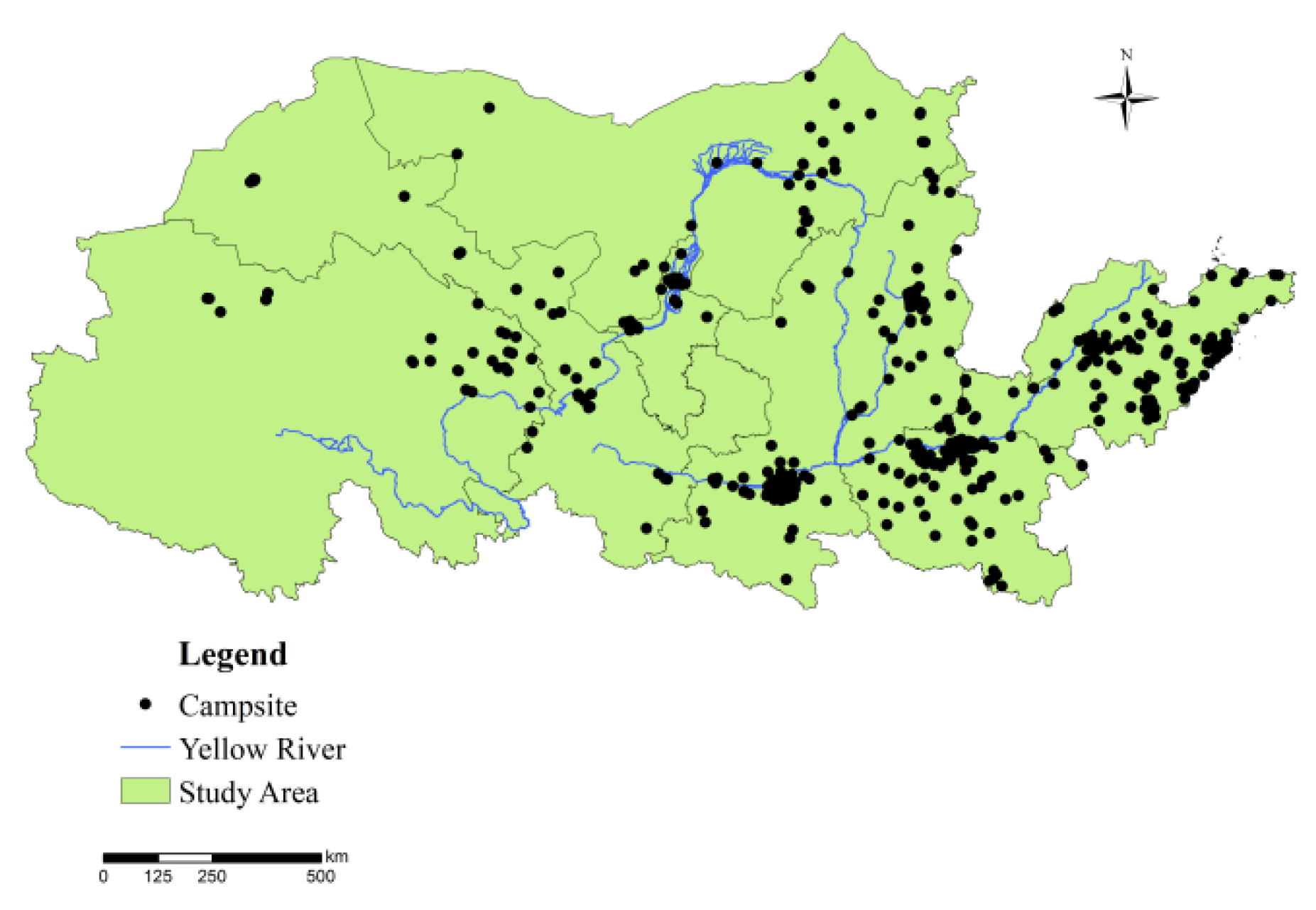
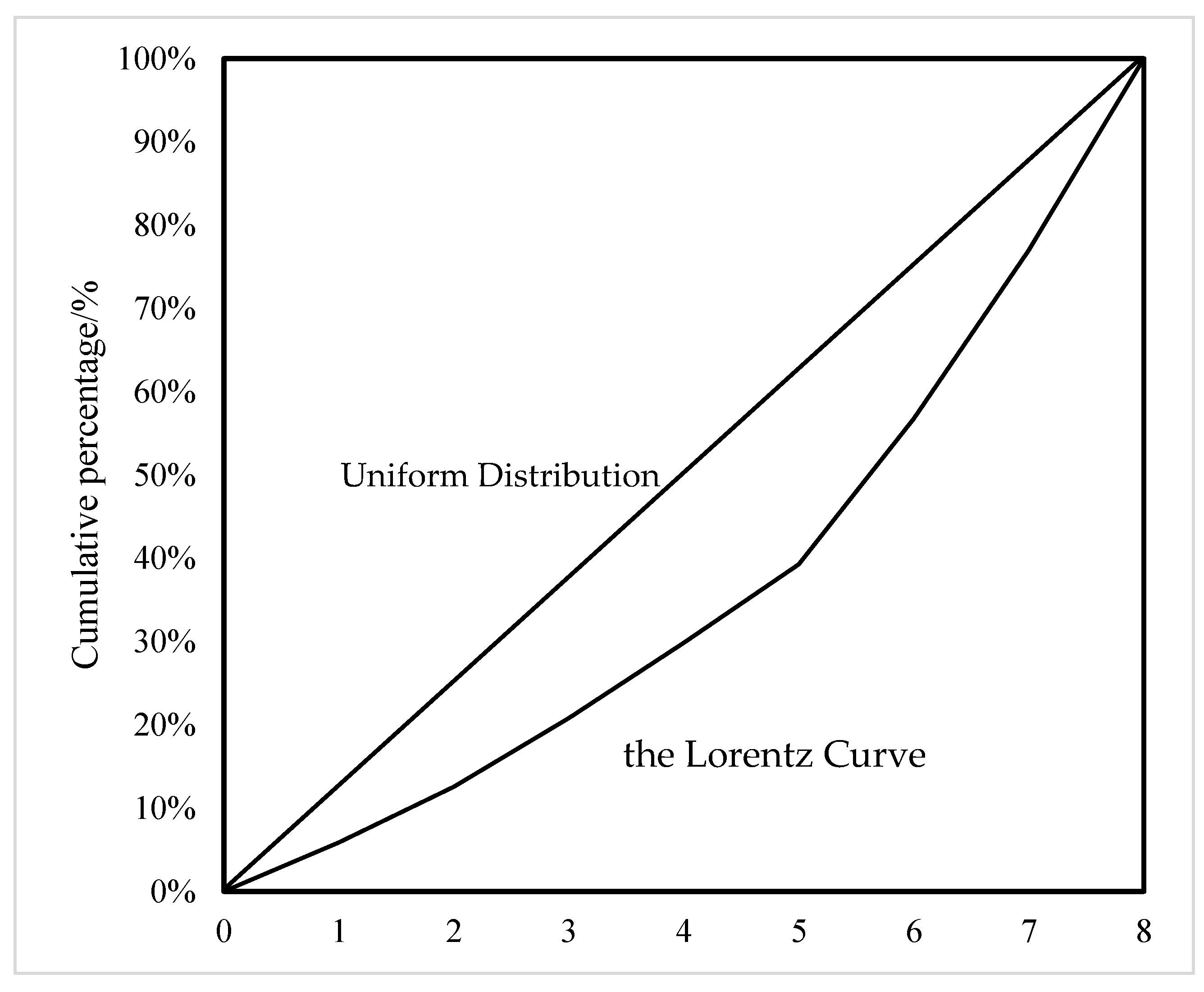

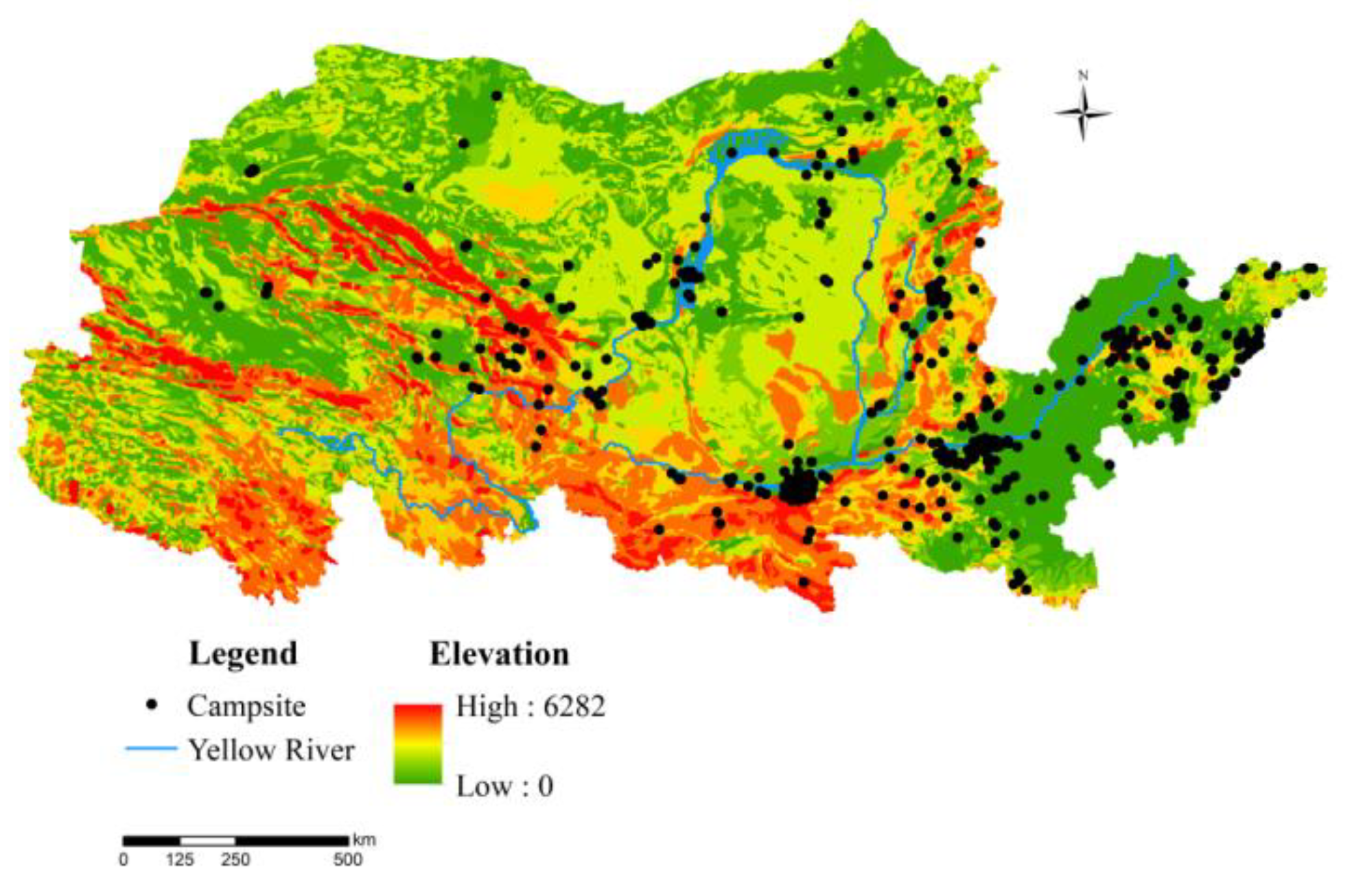
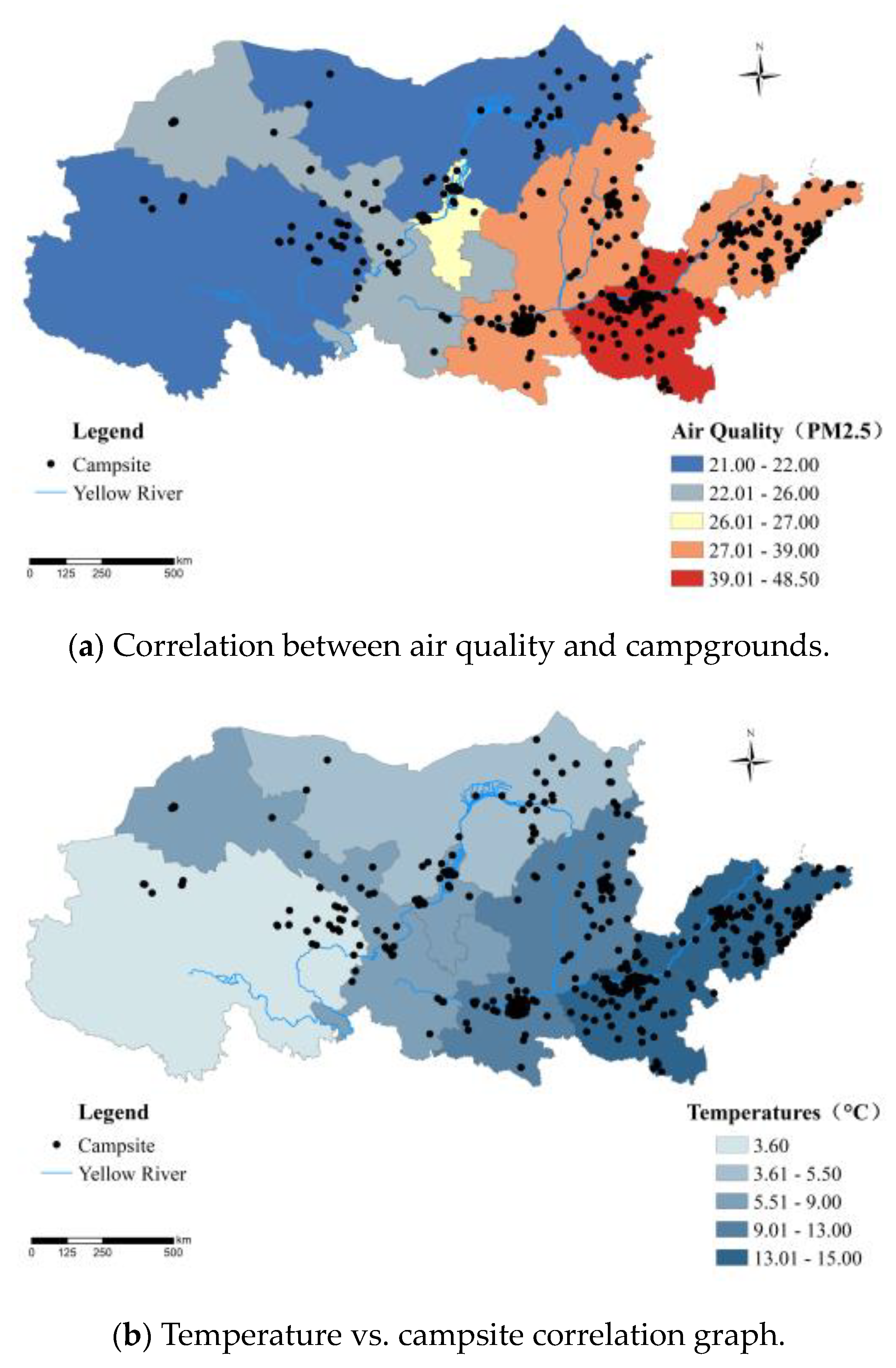
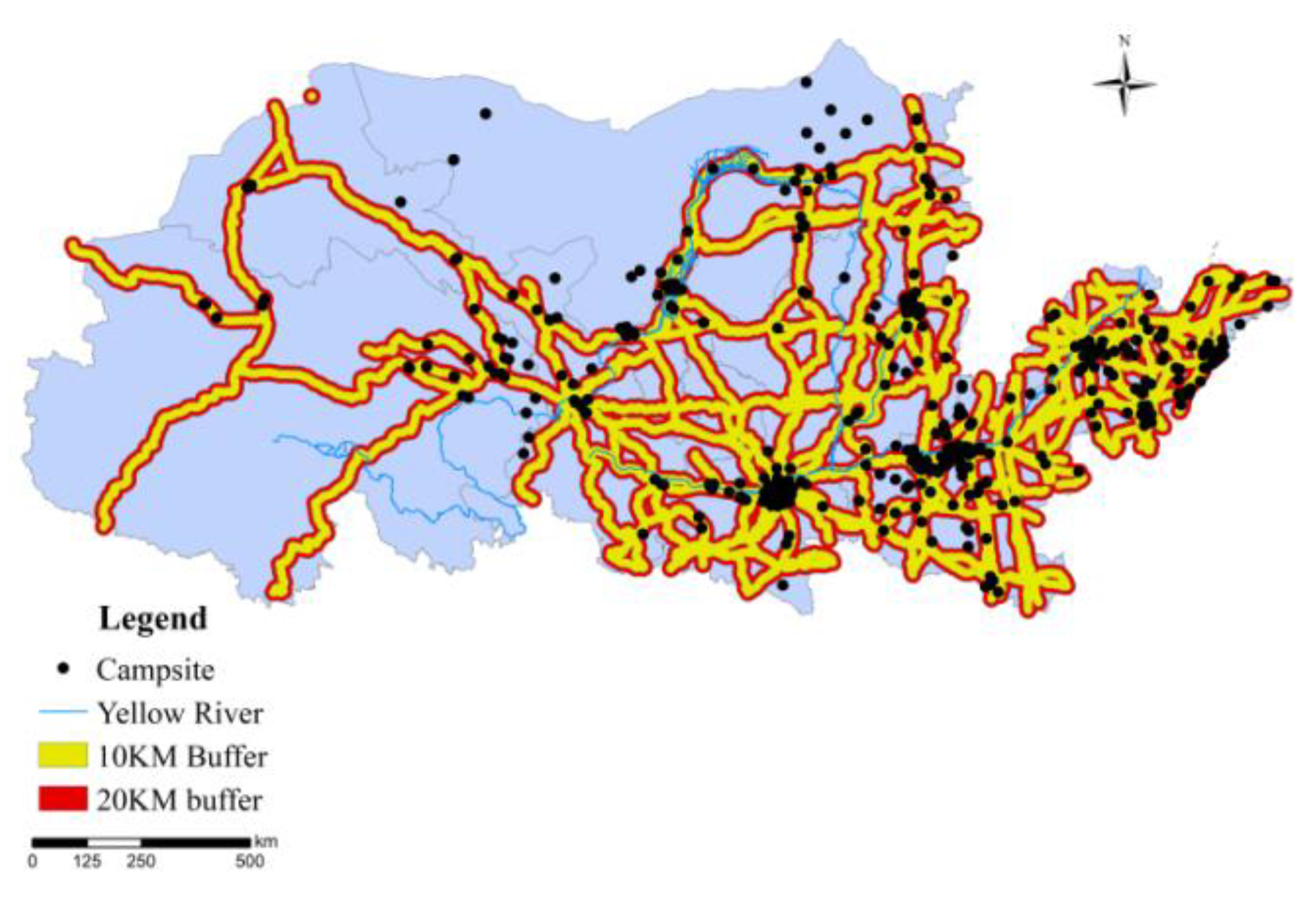

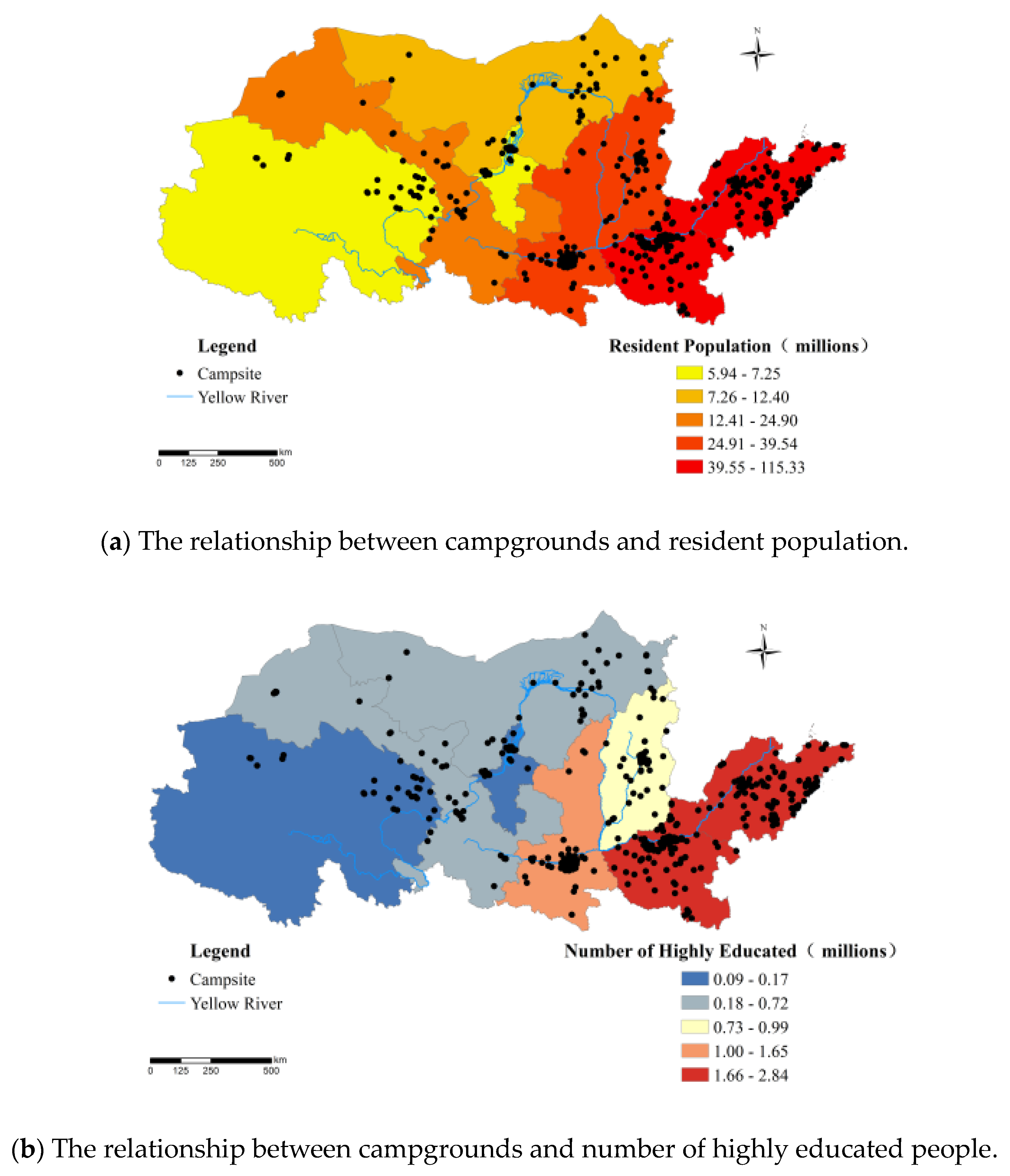
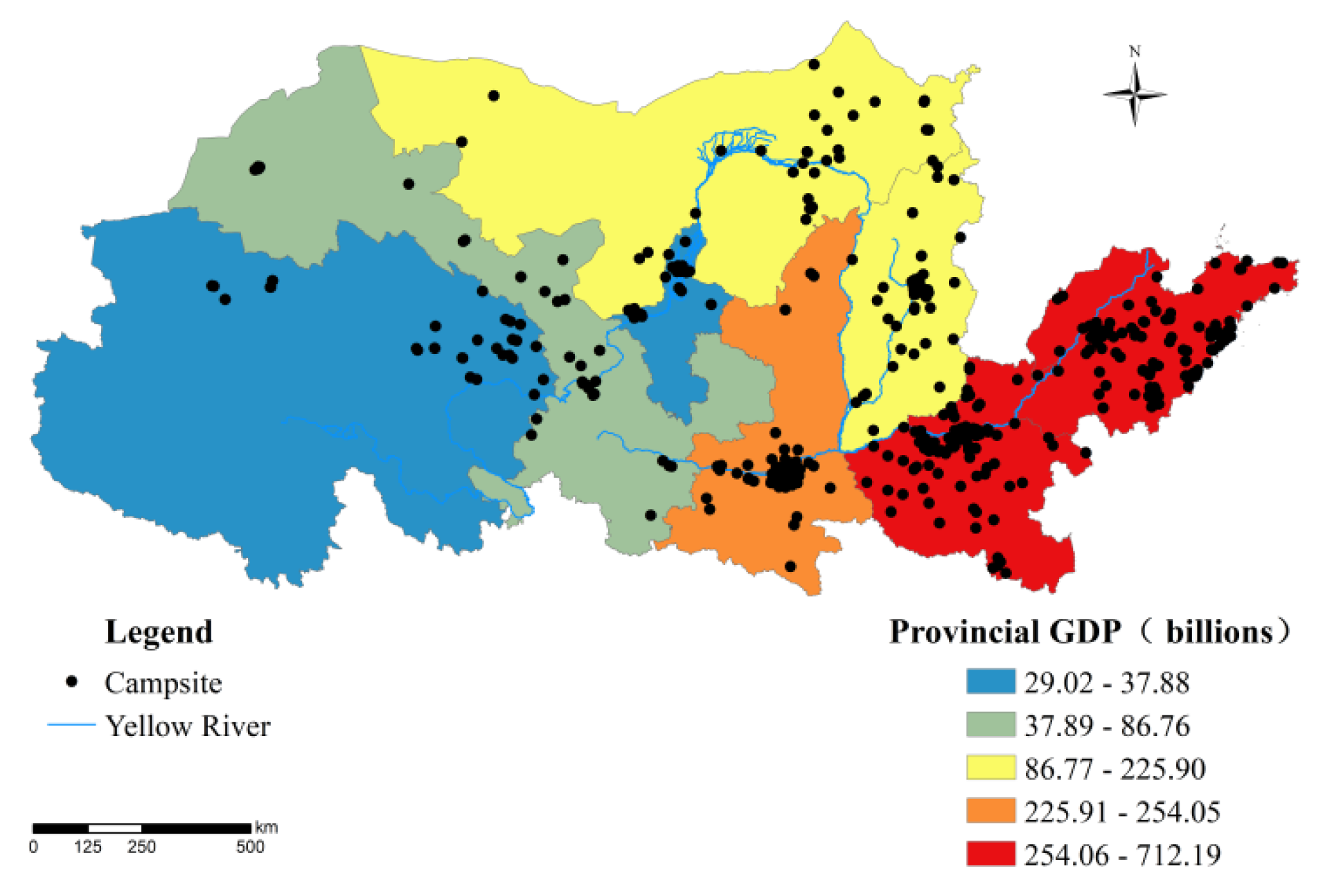
| Province | Number of Campsites | Weighting | Cumulative Weight |
|---|---|---|---|
| Shandong Province | 117 | 22.99 | 22.99 |
| Henan Province | 103 | 20.24 | 43.22 |
| Shaanxi Province | 89 | 17.49 | 60.71 |
| Shanxi Province | 48 | 9.43 | 70.14 |
| Inner Mongolia Autonomous Region | 46 | 9.04 | 79.17 |
| Gansu Province | 42 | 8.25 | 87.43 |
| Ningxia Hui Autonomous Region | 34 | 6.68 | 94.11 |
| Qinghai Province | 30 | 5.89 | 100.00 |
| Influencing Factors | Specific Indicators |
|---|---|
| Geographical Factors | River Network Density (km/km2) |
| Elevation (°) | |
| Altitudes (m) | |
| Number of Geologic Hazards | |
| Environmental Conditions | Air Quality (PM2.5) (μg/m3) |
| Average Annual Precipitation (mL) | |
| Average Annual Temperature (°C) | |
| Transport Condition | Road Mileage (km) |
| Road Passenger Traffic | |
| Distance to Nearest Administrative Center (km) | |
| Tourism Conditions | Number of High-Level Scenic Spots |
| Number of Tourists Received | |
| Demographic and Economic Conditions | GDP per Capita (CNY) |
| Consumption Expenditure per Capita (CNY) | |
| Provincial GDP (billions) | |
| Number of Resident Population | |
| Enrollment Figures for Higher Education Students |
| Indicators of Impact Factors | Pearson’s Correlation Coefficient |
|---|---|
| River Network Density (km/km2) | 0.306 |
| Elevation (°) | −0.266 |
| Altitudes (m) | −0.786 * |
| Number of Geologic Hazards | −0.083 |
| Air Quality (PM2.5) (μg/m3) | 0.942 * |
| Average Annual Precipitation (mL) | 0.579 |
| Average Annual Temperature (°C) | 0.840 ** |
| Road Mileage (km) | 0.914 ** |
| Road Passenger Traffic | 0.215 |
| Distance to Nearest Administrative Center (km) | −0.321 |
| Number of High-Level Scenic Spots | 0.930 ** |
| Number of Tourists Received | 0.909 ** |
| GDP per Capita (CNY) | 0.254 |
| Consumption Expenditure per Capita (CNY) | 0.212 |
| Provincial GDP (billions) | 0.943 ** |
| Number of Resident Population | 0.902 ** |
| Enrollment Figures for Higher Education Students | 0.952 ** |
| Buffer | Quantities | Proportions |
|---|---|---|
| 10 km | 351 | 68.9% |
| 15 km | 439 | 86.2% |
Disclaimer/Publisher’s Note: The statements, opinions and data contained in all publications are solely those of the individual author(s) and contributor(s) and not of MDPI and/or the editor(s). MDPI and/or the editor(s) disclaim responsibility for any injury to people or property resulting from any ideas, methods, instructions or products referred to in the content. |
© 2024 by the authors. Licensee MDPI, Basel, Switzerland. This article is an open access article distributed under the terms and conditions of the Creative Commons Attribution (CC BY) license (https://creativecommons.org/licenses/by/4.0/).
Share and Cite
Fang, X.; Tai, P.; Jiang, F. Study on the Spatial Layout and Influencing Factors of Campsites in the Yellow River Basin. Sustainability 2024, 16, 4944. https://doi.org/10.3390/su16124944
Fang X, Tai P, Jiang F. Study on the Spatial Layout and Influencing Factors of Campsites in the Yellow River Basin. Sustainability. 2024; 16(12):4944. https://doi.org/10.3390/su16124944
Chicago/Turabian StyleFang, Xiaofei, Pengfei Tai, and Fugao Jiang. 2024. "Study on the Spatial Layout and Influencing Factors of Campsites in the Yellow River Basin" Sustainability 16, no. 12: 4944. https://doi.org/10.3390/su16124944
APA StyleFang, X., Tai, P., & Jiang, F. (2024). Study on the Spatial Layout and Influencing Factors of Campsites in the Yellow River Basin. Sustainability, 16(12), 4944. https://doi.org/10.3390/su16124944






